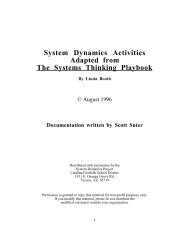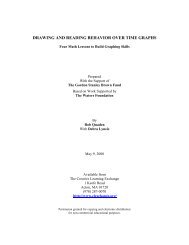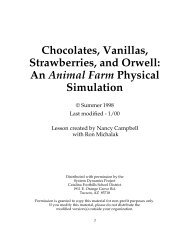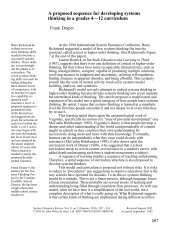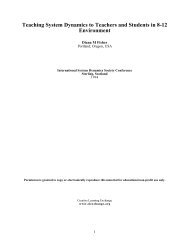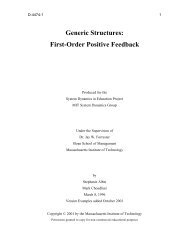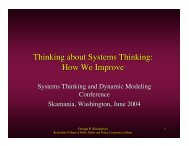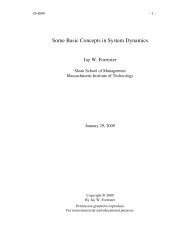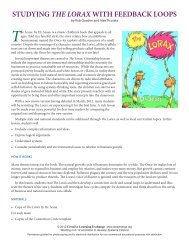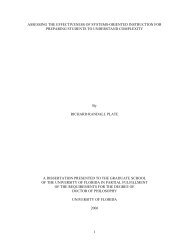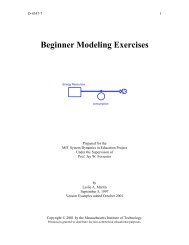Keystone Species in an Ecosystem Using Connection Circles to Tell ...
Keystone Species in an Ecosystem Using Connection Circles to Tell ...
Keystone Species in an Ecosystem Using Connection Circles to Tell ...
Create successful ePaper yourself
Turn your PDF publications into a flip-book with our unique Google optimized e-Paper software.
Here is one example of a connection circle for “The Case of the Tw<strong>in</strong> Isl<strong>an</strong>ds.” Expect studentexamples <strong>to</strong> vary.Ask students <strong>to</strong> expla<strong>in</strong> their arrows: How did a ch<strong>an</strong>ge <strong>in</strong> one element cause a ch<strong>an</strong>ge <strong>in</strong><strong>an</strong>other?o An <strong>in</strong>crease <strong>in</strong> the number of fur traders caused a decrease <strong>in</strong> the number of sea ottersbecause traders hunted <strong>an</strong>d killed sea otters. Also, a decrease <strong>in</strong> traders caused <strong>an</strong><strong>in</strong>crease <strong>in</strong> sea otters because they could multiply unharmed.o An <strong>in</strong>crease <strong>in</strong> the shrimp population caused <strong>an</strong> <strong>in</strong>crease <strong>in</strong> the number of fish becausefish eat shrimp. A decrease <strong>in</strong> the number of shrimp caused a decrease <strong>in</strong> the numberof fish.o An <strong>in</strong>crease <strong>in</strong> kelp pl<strong>an</strong>ts caused <strong>an</strong> <strong>in</strong>crease <strong>in</strong> s<strong>an</strong>d <strong>an</strong>d silt because kelp calmed thewaters allow<strong>in</strong>g sediment <strong>to</strong> be deposited. The <strong>in</strong>creased sediment then buried the seaurch<strong>in</strong>s caus<strong>in</strong>g them <strong>to</strong> decrease. Students might draw <strong>an</strong> arrow suggest<strong>in</strong>g that <strong>an</strong><strong>in</strong>crease <strong>in</strong> kelp caused a decrease <strong>in</strong> urch<strong>in</strong>s, but this is not a direct cause. Rem<strong>in</strong>dstudents <strong>to</strong> be very careful <strong>in</strong> their th<strong>in</strong>k<strong>in</strong>g about what caused what.Remember, these are only sample draw<strong>in</strong>gs.Let students present their own ideas <strong>an</strong>d encourage them <strong>to</strong> weigh the ideas of others.Students are always free <strong>to</strong> ch<strong>an</strong>ge their draw<strong>in</strong>gsas they cont<strong>in</strong>ue <strong>to</strong> ref<strong>in</strong>e their mental models <strong>to</strong>gether.6



